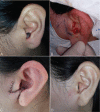Reconstruction of auricular conchal defects with local flaps
- PMID: 27861353
- PMCID: PMC5120910
- DOI: 10.1097/MD.0000000000005282
Reconstruction of auricular conchal defects with local flaps
Abstract
Reconstruction of the auricular conchal cavity is relatively difficult because of its unique structure, shape, and location. We compared different methods of repair of the auricular concha to determine the method that would cause the least injury to the donor site.The method selected was based on the location and size of the defect. If the defect was located in the upper part of the concha, or if the defect was >15 mm in diameter, we used a post-auricular subcutaneous pedicle island flap that was pulled through a post-auricular sulcus tunnel to cover the wound. If the defect was located in the lower part of the concha and was <15 mm in diameter, we used a pre-auricular translocation flap that was passed through the intertragic notch to cover the wound. The donor site was closed primarily. All flaps survived well and any scars associated with the surgery were unnoticeable. No tumor relapse or metastasis was observed over a mean follow-up period of 35 months. All patients were satisfied with the outcome.The periauricular flap technique chosen for reconstruction of skin defects in the auricular concha depends on the size and location of the defect. With appropriate flap selection, excellent functional, and aesthetic outcomes are achieved.
Conflict of interest statement
The authors have no funding and conflicts of interest to disclose.
Figures


References
-
- Reddy LV, Zide MF. Reconstruction of skin cancer defects of the auricle. J Oral Maxillofac Surg 2004; 62:1457–1471. - PubMed
-
- Chen C, Chen ZJ. Reconstruction of the concha of the ear using a postauricular island flap. Plast Reconstr Surg 1990; 86:569–572. - PubMed
-
- Dessy LA, Figus A, Fioramonti P, et al. Reconstruction of anterior auricular conchal defect after malignancy excision: revolving-door flap versus full-thickness skin graft. J Plast Reconstr Aesthet Surg 2010; 63:746–752. - PubMed
-
- Talmi YP, Horowitz Z, Bedrin L, et al. Auricular reconstruction with a postauricularmyocutaneous island flap: flip–flop flap. Plast Reconstr Surg 1996; 98:1191–1199. - PubMed
-
- Talmi YP, Liokumovitch P, Wolf M, et al. Anatomy of the postauricular island “revolving door” flap (“flip–flop” flap). Ann Plast Surg 1997; 39:603–607. - PubMed
MeSH terms
LinkOut - more resources
Full Text Sources
Other Literature Sources
Medical

